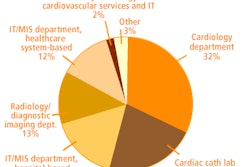Quantitative analysis of diffusion-weighted MR imaging (DWI-MRI) has typically relied on specialized workstations to generate apparent diffusion coefficient (ADC) measurements. But PACS software can handle the job, according to a Web-exclusive study published in the American Journal of Roentgenology.
A research team from Penn State Milton S. Hershey Medical Center found that PACS workstation software can produce ADC measurements as accurately as specialized workstations, eliminating any workflow barriers to more frequent use of these tools and increasing their correlation with other imaging findings.
"Being able to reliably measure ADC values on the routine PACS will save time and lead to increased utilization of ADC values in our diagnostic arsenal, which, in turn, will lead to an improved understanding of the different disease processes and their clinical management, including prognosis," wrote the team led by Reem El Kady.
As functional and molecular imaging become increasingly important in diagnosis and treatment assessment, ADC measurement offers a simple tool for assessing restricted diffusion and cellularity, co-author Arabinda Kumar Choudhary, MD, told AuntMinnie.com.
"However, it is underutilized because most of the radiologists are not aware of the fact that it can be easily and reliably measured on the routine PACS by just drawing a region of interest (ROI) on the ADC image," he said.
To compare the accuracy of ADC values made with PACS workstations and dedicated workstations, the researchers performed a retrospective review of 79 patients with 120 liver lesions of more than 5 mm in diameter. All lesions were clearly demonstrable on the PACS workstation (AJR, March 2011, Vol. 196:3, W280-W284).
Patients were scanned on one of three 1.5-tesla MRI platforms: Intera Achieva (Philips Healthcare), Magnetom Espree (Siemens Healthcare), or Magnetom Avanto (Siemens). A surface coil was used for average-weight patients, and a body coil was employed for obese patients. Standard abdominal MRI sequences were used.
Liver biopsy provided the final diagnosis in 31 patients, while dynamic MRI and follow-up did so in the remaining 48 patients. A variety of liver lesions were included in the study, ranging from highly cellular metastatic lesions to cystic lesions.
ADC maps were initially generated automatically on the main MRI console, and the ADC value for each lesion was measured using a separate, dedicated postprocessing workstation (ViewForum R5.1V1L1, Philips) by placing a region of interest (ROI) on each lesion.
The ADC values were then measured for each lesion again using iSite PACS software (Philips). The values for both the PACS and dedicated workstation were compared using a two-sample t-test.
ADC values measured on the dedicated workstation were 0.4-4.38 x 10-3 mm2/sec, while the PACS produced ADC values of 0.42-4.35 x 10-3 mm2/sec. The difference was not statistically significant, according to the researchers. They also found similar values across different pathologic abnormalities and different MRI magnets.
"In this study, we found no significant difference between the ADC measurements obtained from a commercially availablededicated workstation, which was a direct extension and mirror image of the main MRI console specifically provided by the MRI vendors for all postprocessing, and those obtained from our PACS system," the authors concluded. "The differences between both readings were verysmall irrespective of the type of pathologic abnormality or the MRI platform used, and any difference likely represented slight difference in size and shape of the ROI placed on the two systems."
The authors noted that their results should apply to all types of PACS software.
"Once the data is incorporated in a DICOM format, ADC value as measured on the image by drawing a ROI will remain constant across any viewing software," Choudhary told AuntMinnie.com. "It can be easily measured on the routine PACS workstation by drawing a ROI on the ADC image."




















